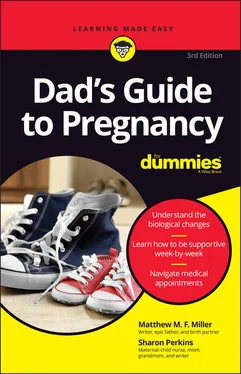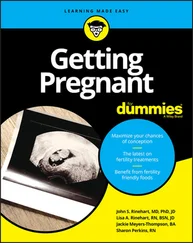Sharon Perkins - Dad's Guide to Pregnancy For Dummies
Здесь есть возможность читать онлайн «Sharon Perkins - Dad's Guide to Pregnancy For Dummies» — ознакомительный отрывок электронной книги совершенно бесплатно, а после прочтения отрывка купить полную версию. В некоторых случаях можно слушать аудио, скачать через торрент в формате fb2 и присутствует краткое содержание. Жанр: unrecognised, на английском языке. Описание произведения, (предисловие) а так же отзывы посетителей доступны на портале библиотеки ЛибКат.
- Название:Dad's Guide to Pregnancy For Dummies
- Автор:
- Жанр:
- Год:неизвестен
- ISBN:нет данных
- Рейтинг книги:5 / 5. Голосов: 1
-
Избранное:Добавить в избранное
- Отзывы:
-
Ваша оценка:
- 100
- 1
- 2
- 3
- 4
- 5
Dad's Guide to Pregnancy For Dummies: краткое содержание, описание и аннотация
Предлагаем к чтению аннотацию, описание, краткое содержание или предисловие (зависит от того, что написал сам автор книги «Dad's Guide to Pregnancy For Dummies»). Если вы не нашли необходимую информацию о книге — напишите в комментариях, мы постараемся отыскать её.
Dad’s Guide to Pregnancy For Dummies
Dad’s Guide to Pregnancy For Dummies
Dad's Guide to Pregnancy For Dummies — читать онлайн ознакомительный отрывок
Ниже представлен текст книги, разбитый по страницам. Система сохранения места последней прочитанной страницы, позволяет с удобством читать онлайн бесплатно книгу «Dad's Guide to Pregnancy For Dummies», без необходимости каждый раз заново искать на чём Вы остановились. Поставьте закладку, и сможете в любой момент перейти на страницу, на которой закончили чтение.
Интервал:
Закладка:
Sperm can only fertilize an egg that’s mature, so you need to either have sperm waiting in the tube when the egg is released or get some there within 12 to 24 hours after ovulation, because that’s how long the egg can live.
 Sperm (shown in Figure 2-2) live for at least a few days — up to five, in some cases — so having sex the day before ovulation, or even two days before, will usually result in live sperm waiting for the mature egg to arrive. If your partner is monitoring her ovulation, give it one more shot the day of ovulation.
Sperm (shown in Figure 2-2) live for at least a few days — up to five, in some cases — so having sex the day before ovulation, or even two days before, will usually result in live sperm waiting for the mature egg to arrive. If your partner is monitoring her ovulation, give it one more shot the day of ovulation.

Illustration by Kathryn Born, MA
FIGURE 2-2:Sperm are compact swimming machines.
Making the journey and attaching to the uterus
After fertilization, the new potential life must make it down the tube to the uterus, where it implants. The journey from fallopian tube to uterus takes five to seven days, on average, and implantation normally occurs seven to ten days after conception. The fallopian tube is normally a fairly straight tube, but if it’s twisted or dilated because of previous infection or pelvic inflammatory disease, the embryo may wander around in the crevasses and never get to the uterus.
WHY SO MANY SPERM?
Women produce one egg a month, most of the time, and men produce millions of sperm. Why the huge disparity? Because one sperm isn’t enough to get the job done — it needs lots of friends to help. Although only one victorious sperm makes it into the egg, breaking down the coating that surrounds the egg takes many sperm. And although eggs get to drift downward from the ovary to the fallopian tube, sperm have to swim upstream. Needless to say, some fall by the wayside, either because they tire or because they take a wrong turn somewhere.
Sperm are also produced in large quantities because many are abnormal, having two tails, no tails, round tails, small heads, large heads, or abnormally shaped heads. Abnormal tails make navigation difficult, and abnormal heads often indicate chromosomal abnormalities.
Only 50 to 60 percent of sperm need good motility, or movement, for a sperm sample to be considered normal, so lots of sperm don’t make the grade, creating a need for higher numbers.
Even worse, the embryo may implant in the fallopian tube, a situation known as an ectopic pregnancy. The tube has no room for a developing fetus, so an ectopic pregnancy is doomed from the start and can cause serious, life-threatening bleeding if the tube ruptures. Ectopic pregnancies occur in around 2 percent of all pregnancies.
Even after the embryo reaches the uterus, it’s not always clear sailing. The uterine lining has to be just right for implantation. Estrogen thickens the lining before ovulation, and progesterone released from the corpus luteum (the leftover shell of the follicle that contained the egg) prepares the lining after ovulation. If either of these hormone levels is low, the lining may not be able to support a pregnancy. Note: Your partner’s medical practitioner can assess the uterine lining by ultrasound and prescribe extra progesterone if needed to achieve and maintain pregnancy.
After the embryo reaches the uterus and implants, the implanted embryo begins to produce human chorionic gonadotropin, or hCG, the hormone that pregnancy tests measure. hCG levels aren’t detectable until the embryo implants, or around the time of the first missed period.
CONCEPTION STATISTICS
If you don’t get pregnant the first month you try, the wheels in your head may start turning as you obsess over why this is taking so long. But pregnancy is by no means a sure thing, even when you do everything right and have no major fertility issues. Statistics say that
Out of 100 couples under age 35 trying to get pregnant over a three month period, 50 achieve their goal, but 20 percent miscarry.
If your partner is in her late 30s, you have a 10 percent chance of pregnancy each month but a 34 percent chance of miscarriage.
If she’s older than 40, you have only a 5 percent chance of pregnancy each month and more than a 50 percent chance of miscarriage.
The good news is that 90 percent of 30-year-olds trying to get pregnant become pregnant within a year, and 66 percent of 35-year-olds get pregnant in a year. Around 44 percent of 40-year-olds become pregnant within a year. Over age 40, variables such as hormone levels affect pregnancy rates, and generalizations are hard to make. Timing intercourse to ovulation can increase the chance of getting pregnant to 76 percent in the first try, for those under 30.
Answering FAQs about getting pregnant
Getting pregnant may seem straightforward, but what exactly does it take? Here are some answers to the most common concerns:
How long does it take to get pregnant?On average, more than half of couples under age 35 get pregnant within the first six months of trying, and four out of five are pregnant within one year.
Does having more sex increase the chances of pregnancy?
No. In fact, due to the amount of time it takes for semen volume to build back up to normal levels following ejaculation, overdoing it around ovulation time by having sex several times a day can deplete your sperm count, which probably won’t be a problem if you have a normal sperm count but can be if your count is low.
Should we only have sex with my partner on her back and me on top?It’s a myth that this standard position is the best way to get pregnant. Although it may help the semen stay in better, no scientific proof exists that the sexual position you choose has any effect on conception rates. Feel free to experiment, especially if it makes having sex less like a chore and more like something you do for fun — you know, like the good old days.
Does my partner’s past use of the birth control pill mean getting pregnant will take longer?It varies from person to person. One woman can miss a single pill and end up pregnant; others may take a little longer to return to their regular ovulation pattern. The chances of getting pregnant the first month are small, but the average couple is pregnant within a year, regardless of past birth-control usage.
Is it okay to drink and smoke when trying to conceive?If you’re ready to start a family, you should both give up smoking immediately. Occasionally having a drink or two when you’re trying to become a mom or dad won’t likely produce a negative outcome, but the general rule of thumb is to live as though your partner is pregnant from the moment you begin trying to conceive. Check out the section “ Assessing lifestyle choices that affect eggs and sperm,” later in this chapter, for more tips on getting healthy to improve the odds of conception.
Tracking the Journey: Using Fertility Apps and Monitors
If you need one more reason to play with your smartphone, or if you’re the type that lives to organize data, using a fertility app can make getting pregnant more fun and sometimes a bit easier. Yes, you could do much the same with a diary or written calendar, but if you have an app on your phone, you’ll always be able to find it. A few even have a place for dad-to-be data, to help spot possible issues.
Fertility apps, which can range in price from free to up to $100 a year, can make the baby journey easier by tracking
Your partner’s normal cycle schedule
Читать дальшеИнтервал:
Закладка:
Похожие книги на «Dad's Guide to Pregnancy For Dummies»
Представляем Вашему вниманию похожие книги на «Dad's Guide to Pregnancy For Dummies» списком для выбора. Мы отобрали схожую по названию и смыслу литературу в надежде предоставить читателям больше вариантов отыскать новые, интересные, ещё непрочитанные произведения.
Обсуждение, отзывы о книге «Dad's Guide to Pregnancy For Dummies» и просто собственные мнения читателей. Оставьте ваши комментарии, напишите, что Вы думаете о произведении, его смысле или главных героях. Укажите что конкретно понравилось, а что нет, и почему Вы так считаете.












